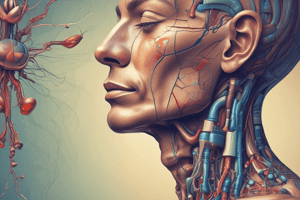Podcast
Questions and Answers
What is a key characteristic of acute pain?
What is a key characteristic of acute pain?
- It often leads to depression and fatigue.
- It is usually self-limiting. (correct)
- It lasts longer than 3 months.
- It primarily arises from nerve damage.
Which type of pain is characterized by ongoing symptoms lasting longer than 3 months?
Which type of pain is characterized by ongoing symptoms lasting longer than 3 months?
- Acute pain
- Neuropathic pain
- Chronic pain (correct)
- Nociceptive pain
What physiological responses are typically associated with chronic pain?
What physiological responses are typically associated with chronic pain?
- Heightened fight-or-flight responses
- Lower than normal vital signs (correct)
- Significant muscle tension
- Increased vital signs
Which of the following is an example of nociceptive pain?
Which of the following is an example of nociceptive pain?
What describes neuropathic pain?
What describes neuropathic pain?
Which type of pain is typically managed using opioids?
Which type of pain is typically managed using opioids?
What is a common behavioral response to acute pain?
What is a common behavioral response to acute pain?
Which of the following can lead to functional impairment in patients experiencing chronic pain?
Which of the following can lead to functional impairment in patients experiencing chronic pain?
Flashcards
Acute Pain
Acute Pain
Protective, temporary pain that usually resolves with tissue healing.
Chronic Pain
Chronic Pain
Ongoing or recurring pain lasting longer than 3 months.
Nociceptive Pain
Nociceptive Pain
Pain from damage or inflammation of tissues not involved in the nervous system.
Neuropathic Pain
Neuropathic Pain
Signup and view all the flashcards
Somatic Pain
Somatic Pain
Signup and view all the flashcards
Visceral Pain
Visceral Pain
Signup and view all the flashcards
Chronic Pain Classification
Chronic Pain Classification
Signup and view all the flashcards
Pain Interventions
Pain Interventions
Signup and view all the flashcards
Study Notes
Acute Pain
- Protective and Temporary: Acute pain is a protective mechanism, usually short-lived, and resolves as tissue heals.
- Physiological Responses: Fight-or-flight responses (e.g., tachycardia, hypertension, anxiety, diaphoresis, muscle tension) occur.
- Behavioral Responses: These include observable behaviors such as grimacing, moaning, flinching, and guarding.
- Absence of Response Doesn't Equal Absence of Pain: A lack of physiological or behavioral responses doesn't mean pain is absent.
- Interventions: Treatment focuses on addressing the underlying cause of the pain.
- Examples: Surgical incisions and injuries cause acute pain.
Chronic Pain
- Not Protective: Chronic pain is not a protective mechanism; it is ongoing or recurs frequently.
- Duration: Lasts 3 months or longer and persists beyond tissue healing.
- Physiological Responses (Often Opposite of Acute): Vital signs are often lower than normal, not elevated.
- Associated Symptoms: Can lead to depression, fatigue, decreased functionality, or disability.
- Unspecified Cause: May not have a readily apparent cause.
- Treatment Difficulty: May not respond well to standard interventions.
- Categories: Chronic cancer pain and chronic non-cancer pain.
- Examples: Pain from osteoarthritis and neuropathy.
Nociceptive Pain
- Source: Arise from damage or inflammation to tissues (not nerves), including peripheral and central nervous systems
- Mechanism: Normal processing of painful stimuli is activated.
- Characteristics: Often described as throbbing, aching, and localized.
- Treatment: Typically managed with opioids and non-opioid medications.
- Types:
- Somatic: Pain in bones, joints, muscles, skin, or connective tissues.
- Visceral: Pain in internal organs (e.g., stomach, intestines) and can refer to different regions
Neuropathic Pain
- Source: Caused by abnormal or damaged pain nerves.
- Mechanism: Abnormal or distorted processing of painful stimuli.
- Characteristics: Often severe, characterized by a shooting, burning, "pins and needles" sensation.
- Treatment: Primarily managed by adjuvant medications (e.g., antidepressants, antispasmodics, skeletal muscle relaxants).
- Examples: Phantom limb pain, pain below spinal cord injuries, diabetic neuropathy.
Studying That Suits You
Use AI to generate personalized quizzes and flashcards to suit your learning preferences.



